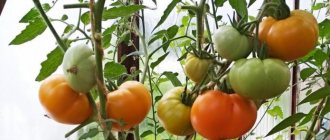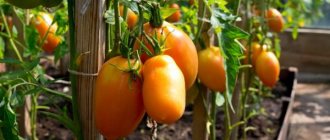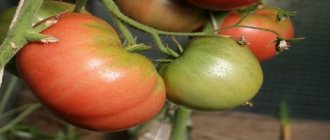The Black Moor tomato, the description and characteristics of the variety of which are presented in our article, was bred and registered by Russian breeders in 2000.
the Black Moor tomato variety by crossing red and wild tomatoes. The resulting specimen attracts with its appearance, as it has a chocolate color.
Important! The Black Moor was created not through genetic engineering, but through selection.
Its fruits are consumed fresh and for preservation due to their small size. Tomatoes have good taste and are also resistant to transportation.
Characteristics and description of the variety
- The Black Moor tomato variety is intended for growing in open ground, in greenhouses, hotbeds and under film
- These tomatoes are semi-determinate. The bushes stop growing, reaching a height of 1.5 m.
- After 8-9 leaves, the first brush is formed, and subsequent ones begin to appear after every 3 leaves. To properly create a bush, it must be formed by removing the stepsons (leaving 10-11 brushes).
- Has a medium ripening period. Tomatoes appear 115-125 days after the first shoots.
- Several shoots are formed on the bush, which have medium-sized green leaves. A specific feature of this plant is short internodes.
- Up to 10 fruits are usually formed on 1 cluster. However, with good care their number can reach 18 pieces.
- Productivity per 1 sq. meter area ranges from 5 kg to 5.5 kg.
Interesting! This pleasant color is created by combining purple and red dyes from different varieties of tomatoes.
Characteristics of the Black Moor tomato
The Black Moor tomato grows easily, given its characteristics. We must not forget that tomatoes are a heat-loving crop that requires specific care if you want a harvest and not a dead bush.
Productivity and fruiting
From the moment the seeds are planted, 3.5 months must pass until the harvest ripens. In warm, light summers, the period can be shortened, in cold, dark summers it can increase.
Other factors also influence the duration of ripening and yield:
- there are more Black Moor fruits in the greenhouse, they ripen faster;
- timely fertilization will help increase productivity;
- Watering according to the schedule will improve the quality of the fruit.
Up to 6 kg of fruits are collected from each square meter. In open ground, the yield can be reduced to 4–4.5 kg; in a greenhouse, it is possible to grow a maximum of tomatoes. In southern latitudes, plants don’t care where to grow, but the further north you go, the more important the presence of a greenhouse is.
Important! Without fertilizing, when grown in the ground, “Black Moor” tomatoes will produce an amount of fruit that is unreasonably small relative to the effort expended.
Area of application of fruits
Taste qualities and characteristics of the variety make it possible to use the fruits for:
- canning;
- use in salads;
- food in unprocessed form.
It is not recommended to place this variety in hot dishes that require the tomato skin to be removed or completely disintegrated.
Resistance to diseases and pests
The tomato is considered medium resistant. The Black Moor variety is susceptible to late blight, fusarium and other fungi. The tomato is relatively resistant to pests and diseases of other varieties.
During a massive invasion of parasites or an epidemic of late blight, this variety will not save anything; the lack of high resistance is not compensated by spraying or closing the greenhouse.
In the greenhouse, the Black Moor bushes grow healthier and stronger than in open ground. In the latter case, you should regularly check whether the plant is sick and spray it at the first sign of problems.
Advantages and disadvantages of the variety
According to reviews and photos of those who planted the Black Moor tomato, the variety has more advantages than disadvantages.
Positive traits:
- big harvest;
- original color of pulp and skin;
- canning possibilities;
- resistance to extreme climatic conditions;
- ability is stored for a long time.
Among the negative aspects, low resistance to disease is noted. Another disadvantage is small fruit, which is not significant for everyone; many, on the contrary, consider this trait to be an advantage.
Among the disadvantages, some gardeners note the fragility of the bushes and the need for garter. But this is a common property of tomato bushes.
Photo
Below are photos of the Black Moor tomato variety
Agrotechnics of cultivation and care
In Russia, due to climatic conditions, Black Moor tomatoes are grown only by seedlings. The optimal period to start preparing seeds and planting them in the ground is the second half of March. During this period, daylight hours are significantly longer, and there is no need to additionally illuminate the seedlings.
Black Moor seeds must be pre-treated - this will strengthen their immunity and improve resistance to diseases and pests. First of all, the seed needs to be kept in a slightly pink solution of potassium permanganate for 15-20 minutes, then rinsed with plain water.
After this, before planting, tomato seeds can be soaked in a nutrient solution prepared from special products - for example, “Bud” (2 g/l of water), “Agricola 6” (1 tsp/l), “Effecton-O” ( 3 tsp/l) and others. The temperature of the solution should be about 20 degrees, the seeds are first placed in a linen bag. They need to be kept in this solution for 24 hours.
As soil for this variety, you can use a mixture prepared from peat, turf soil and humus in a 1:1:1 ratio. Potassium sulfate, urea and superphosphate are also added to the soil (1 tsp per bucket). The soil is treated in an oven at a temperature of 110-115 degrees for 20 minutes.
Seeds are planted to a depth of about 1-2 cm in treated soil, placed in small containers or boxes for tomato seedlings and pre-watered with a small amount of nutrient solution to soak the planting material. The container is placed in a warm and well-lit room, where the air temperature is maintained at around 22-25 degrees, and the future seedlings are covered with film for the first days. Shoots will appear on days 5-6, after which the covering material is removed. You cannot water the Black Moor bushes often - once a week is enough.
After the sprouts have 2 full-fledged leaves, they are picked into separate containers if the seedlings were planted in common boxes. Before the procedure, the soil is spilled, but no later than 3 hours before seating.
The sprouts of the Black Moor develop into full-fledged young bushes within 45 days. During this time, they need to be fed twice with complex fertilizers with an interval of 14 days. The first feeding is done in the phase of 1 leaf, the second – 12 days after picking.
We recommend reading
The benefits and harms of tomatoes for the human body
What to do if tomato leaves turn yellow in open ground and greenhouse
What to do if yellow spots appear on tomato leaves
The main reasons for curling leaves in a greenhouse
Before moving the bushes into open ground, they are hardened off for a week. It is necessary to periodically take the plants into a cool room - to a loggia, terrace. You can simply open the window, but avoid drafts.
The Black Moor is planted for permanent residence at the end of May, when the weather stabilizes and there is no threat of frost. It is best to opt for loose, fertile soil. The tomato planting pattern is in a checkerboard pattern, each bush is located at a distance of about 50-60 cm from the neighboring one. For the first 12-15 days from the moment of planting, tomatoes are not watered.
Black Moor has tall bushes and needs to be tied to tall trellises. When forming, the bush is led into one or two stems, leaving 7-8 flower-bearing racemes. Do not forget about regular ventilation of the greenhouse, watering (every 5-6 days, 4-5 l/m2) and loosening the soil around the stems.
Attention! During the flowering period, watering tomato bushes should be more abundant - approximately 10-15 l/m2.
The Black Moor is fed 4-5 times per season:
- 20 days after planting the seedlings (“Effecton-O” and “Agricola-Vegeta”, it is enough to take 1 tbsp. L./10 L. About 1 L is needed for one bush);
- 10 days after the first (“Agricola-Vegeta” 1 tbsp. and “Agricola 3” 20 g are stirred in 10 liters. 5 l/m2 is enough);
- 10 days after the second (Nitrofoska 2 tbsp and “Effecton-O” at the rate of 1 tbsp per 10 liters of water);
- after waiting 12 days from the moment of the third (potassium sulfate and superphosphate are taken 1 tbsp/10 l. Consumption - 5-6 l/m2):
- after waiting about 12 days from the moment of the fourth (“Effekton-O” 2 tbsp/10 l, approximately 5-6 l/m2 are spent).
Advantages and disadvantages
Black Moor has undoubted advantages:
- This variety of tomatoes can be grown in a greenhouse and in open ground.
- Not afraid of temperature changes.
- Clustered tomatoes are easy to pick.
- One of the most productive varieties, up to 18 tomatoes are formed on 1 bunch.
- Small fruits with a thick skin are convenient to use for home canning.
- Due to the high density of the pulp, it is possible to transport tomatoes over long distances.
- No special conditions are required to grow this variety. A novice gardener can safely plant such bushes.
Flaws:
Black Moor tomatoes have many advantages, however, there are also some disadvantages, like all crops. If you do not pay enough attention to the plant, it may become sick and be attacked by harmful insects.
Pests that are dangerous for this variety:
- aphid;
- spider mite;
- mole cricket;
- Colorado potato beetle, etc.
Tomato diseases:
- verticillium;
- mosaic;
- fusarium;
- spotting;
- late blight
Some gardeners, according to reviews, do not like the taste of Black Moor tomatoes due to their sourness. However, recently these tomatoes have become more popular.
Diseases and prevention, pest control
The Black Moor variety is characterized by average resistance to diseases. Most often, this tomato is affected by fungi. Experienced gardeners advise using the following means in the fight against plant diseases:
- Late blight is quickly eliminated by a solution of Bordeaux mixture;
- for gray rot and other fungal diseases, the drug HOM and its analogues are needed;
- karbofos will help cope with spider mites;
- if caterpillars appear, the soil must be dug deep and the bushes treated with arrow;
- If there is a whitefly, the drug Confidor will help.
Treating tomatoes against pests
Features of cultivation
The seeds of these tomatoes are sown from the second decade of February, 60-65 days before the intended planting in the ground. After the seedlings have the first 2 leaves, the seedlings are picked.
Before transplanting tomatoes to a permanent place, it is necessary to keep the seedlings for 1.5-2 months. Planting scheme - per 1 sq. m plot for up to 4 plants.
More information about growing tomatoes is described in the article: Technology of growing tomatoes. Secrets of planting and care.
You might be interested in: How to properly plant tomatoes in a greenhouse: bush formation diagram, care features, photos and videos
Useful information: How to properly tie tomatoes in open ground: the best methods, step-by-step photo and video instructions
Care
With constant good care, Black Moor tomatoes are able to thank the owner with a good harvest.
Without watering, fertilizing and protection, the plant will die or produce a very meager harvest. First of all, the plant is watered at least once every 5-7 days and fed every 2 weeks. After watering, after 20-30 hours the soil is loosened, this will remove the crust and improve oxygen access to the roots of the tomatoes.
The Black Moor tomato variety is formed depending on the planting density of 1-3 stems. The sparser the bushes are planted, the more stepchildren you can leave. To ensure that the fruits do not come into contact with the soil, the stems must be tied to supports or twine.
After ripening and collecting the fruits from the first cluster, it is better to remove all lower leaves. This will ensure air circulation in the lower part of the greenhouse and reduce its humidity. After all, as you know, it is high humidity that allows many diseases to develop, especially late blight.
As plants grow, preventive measures are taken to prevent diseases and, if necessary, combat them. For this purpose, drugs of domestic and foreign production are used.
If a gardener wants to grow eco-products, then it is worth paying attention to traditional methods of combating fungal and viral infections. Many of them are able to resist these diseases.
Increased yield
For better yield of the variety, it is recommended to maintain looseness of the soil, preventing the formation of earthen crusts. Another simple way is regular weeding. Timely freeing of the plant from weeds prevents soil depletion and accelerates the ripening of fruits. It’s worth looking at the next three methods in a little more detail.
Stepsoning
The pinching procedure should be carried out regularly to avoid excessive bush density. The essence of the event is to remove excess shoots in the leaf axils. If the stem is too branched, this will reduce both the size of the fruit and their number. Therefore, as soon as additional shoots reach a length of 5 cm, they should be carefully broken off. Since the variety is semi-determinate, it is not recommended to remove smaller shoots in order to make sure that these are stepsons and not the main stems.
Top dressing
Don’t forget about this method of increasing productivity as fertilizing. Tomatoes of this variety are fertilized three times from the moment the seedlings are transplanted until the first fruits appear. Nitrogenous substances provide good growth of green mass, but this is not the best preparation for fruit formation, so be careful when using it. The optimal mineral fertilizers for feeding Black Moor tomatoes are superphosphates, potassium sulphide and ash.
Immediately after planting seedlings in open ground, it would be appropriate to replenish the soil with phosphate preparations, as they have a beneficial effect on the development of the root system. In the future, it will be good to saturate the soil with potassium and organic matter. Among organic fertilizers, infusions of chicken manure and mullein are used to benefit productivity.
Please note that any fertilizers should be applied only before fruit set, because active growth of the vegetative part of plants is needed only before this period
Tying up
Tomatoes of the “Black Moor” variety are tall crops, so fruits form on the bushes and need staking. This procedure will prevent stem breakage, provide better illumination to ripening tomatoes, and protect against damage from rain and wind. Thus, thanks to the garter, the plant no longer wastes energy on survival, and directs all its juices to ripening the fruits.
To properly tie a bush, you need to drive a wooden peg next to it about 15-20 cm taller than the plant itself. Then tie the stem to it using ribbons or clamps purchased in special stores. You can also use homemade ribbons from fabric you don’t need, but in this case it is better to use synthetic material as a basis, as it is resistant to rotting.
It is recommended to make the garter itself at the highest possible place on the stem and, as the crop grows, move its top or add new ones. You should also not use much force when tightening the tape or clamp, so as not to damage the plant.
So, after reading this article, you learned the characteristics of the Black Moor tomato variety and the features of their cultivation. Let's summarize briefly:
- Black Moor tomatoes have excellent taste. They are good for canning, transportation and long-term storage.
- Plants are relatively unpretentious and easily tolerate temperature fluctuations.
- To grow seedlings, it is necessary to harden and disinfect the seeds, as well as prepare containers and soil.
- Before planting in the ground, seedlings also need to be hardened off in the fresh air.
- “Black Moor” is highly susceptible to fungal diseases, so it is recommended to hill up the plants and use special preparations.
- The variety is famous for its yield of up to 7 kg per bush.
- To obtain the maximum number of fruits, you need to weed the plants during the growing process, feed them, and regularly carry out the pinching procedure.
- When clusters of fruit appear, do not forget to tie up the bushes in time to protect the stem from breakage.
Grow this wonderful variety of tomatoes on your plots and enjoy the wonderful taste of its fruits!
In the next video you will find a review of the Black Moor tomato variety.
Planting tomato seedlings in the ground
At this stage, plant care activities are similar, but still have their own nuances.
Watering
Since the “Black Moor” is afraid of dampness, it should be watered no more than once every 7 days. It is not the leaves that need to be watered, but the stem at the base so that the roots are saturated with water.
Feeding
Feeding is done twice. The first time occurs, as indicated above, when transplanting plants to a permanent place, and the second time - at the beginning of fruiting.
Stepsoning
This variety requires pinching due to the rather vigorous growth of shoots. There is no consensus on how to do pinching: some gardeners suggest leaving one stem, while others prefer two stems. Nevertheless, they agree that the lateral stepsons are trimmed very short and as they appear.
Soil care
For this purpose, the soil is regularly loosened to make it easier for the roots to access water from irrigation and air. In addition, weeds are regularly weeded, as they prevent the tomato from growing normally.
Did you know? Biological “relatives” of the tomato are tobacco and potatoes.
Mulching is also carried out, mainly to retain moisture in the water and maintain temperature balance.
Tying up a bush
Due to the large height of the bush, it needs timely staking. It is carried out as the tomato grows. In the case of the “Black Moor”, not only the stem, but also the clusters that have many fruits must be tied up, otherwise they will break the plant.
The main threats to the Black Moor are fungus and dampness, so it is extremely important to avoid excess watering. In addition, the following are suitable for prevention:
- Bordeaux mixture;
- "Confidor" (fights whitefly);
- "Karbofos" (fights spider mites);
- “Barrier” (increases resistance to various negative influences).
The “Black Moor” cannot boast of titanic size or high resistance to disease. However, its amazing taste and original appearance will hardly leave anyone indifferent, and its high temperature resistance significantly expands the range in which it can be cultivated.
It is recommended to choose areas with maximum access to sunlight and where the following were previously grown:
- onion;
- cucumbers;
- legumes;
- cabbage;
- zucchini.
For Black Moor tomatoes, a minimum of organic fertilizers (humus) and more nitrogen (0.5 kilograms per square meter) and phosphorus (0.2 kilograms per square meter) are added to the soil. In no case should there be an excess of moisture in the soil - this significantly increases the likelihood of developing late blight. But dry soil is not suitable for planting seedlings.
If planting is planned in a greenhouse, then the soil is fertilized in the same way as in an open area; mulching is not carried out. The main thing is to loosen the soil as thoroughly as possible.
We invite you to read: Useful properties of mint Recipes for youth 2019
Cultivation
Tomato Black Crimea
You can plant this variety of tomato in the garden, in a greenhouse, or a hotbed. It should be noted that a tomato grown in a garden, being in more natural conditions, can be just over a meter high, in contrast to greenhouse crops, which are constantly reaching for the light.
Seedling
Requirements for planting soil
To grow seedlings you will need the following containers:
- Peat glasses;
- Plastic and paper glasses;
- Wooden boxes;
- Cut bottles.
The ideal option would be to sow the seeds of the Moor tomato in glasses made of paper or peat. In the future, the finished seedlings can be planted in the same containers in the garden or greenhouse.
Seeds develop very quickly if planted in crushed coconut fibers. This material promotes the development of strong roots.
You also need a mixture of humus and turf soil. Moor tomatoes love loose soil. Therefore, sawdust should be added to the soil.
A week before planting, the container with soil should be kept at a temperature of about +25ºС.
Seed preparation
A very important and responsible point is the preparation of seeds. If the crop will grow in the garden, the seeds must first be hardened.
Tomato Black Moor fruit
To do this, place the seeds in a convenient container in the cold for 2 days, for example, you can put them in the refrigerator.
The following procedure is to test for germination: moistened seeds are kept for 5 days at +20...+25ºС
To eliminate potential fungi, the seeds are treated with bleach, manganese solution, copper sulfate, and fungicides.
Finally, the seeds are washed with water and sown in the soil.
Sowing rules
They usually start sowing in March.
In order for seeds to germinate quickly, it is necessary to create the following conditions:
- Loose soil;
- Keep containers with planting material in a warm and sufficiently bright place;
- Mandatory watering after sowing and when shoots appear.
Recommendations from experienced gardeners will help you get healthy, strong seedlings of Moor tomatoes:
- The seed should not be placed deeper than 20 mm, otherwise it will rot;
- When sowing grains, you need to maintain a distance of 2 cm;
- With a small percentage of germination, planting is done more densely;
- The container with seed material is covered with film;
- Diving is carried out after 2-3 finished leaves.
Transplanting tomatoes Black Moor
The seedlings are transferred to the prepared area 50-55 days after germination. At this time there are usually no frosts.
The earth is watered abundantly.
The Black Moor tomato has large, fleshy fruits
Planting is carried out in several ways:
- Double-line tape, when a sufficient distance separates a pair of bushes;
- In a checkerboard pattern;
- Nests, placing a couple of seedlings in the hole.
Tomato care
After transplanting seedlings, you need to provide them with proper care:
Taking into account that the bush grows to a height of more than a meter, and the fruits on it are in abundance, a garter should be carried out; for this, trellises and pegs are installed; Excess stepsons must be removed in a timely manner to increase productivity; Blooming brushes vibrate gently for good pollination; With the onset of flowering, the Black Moor needs increased watering, but not excessive; Water the tomatoes in the late afternoon, when the sun does not burn; Weeding is carried out weekly and the soil under the bushes is loosened.
Greenhouse plants are watered regularly, regardless of the weather. Bushes should not be left on the ground to prevent insects or fungi from destroying them.
Even if the Black Moor grows on fairly fertile land, it needs feeding. Enrich the soil with phosphorus and potassium. They do this several times during the season.
Important! Excess, as well as lack of organic matter and minerals, are equally harmful to tomatoes.
Disease Prevention
For the Black Moor tomato, the characteristics and description of the variety indicate an average degree of resistance to diseases. To prevent infection, you need to treat tomatoes with Hom and carry out hilling.
Bordeaux mixture can prevent late blight. Karbofos can successfully deal with spider mites, which leave holes on the leaves.
Spider mite
Using traditional methods to combat ticks, a spray solution is prepared. The infusion contains garlic, dandelion leaves, and liquid soap.
The caterpillars are collected by hand and treated with the chemical Strela. When yellowness appears on the foliage or the bush wilts, Confidor is used, which destroys the whitefly that destroys the tomato.
Important! The introduction of any chemical substances is prohibited from the end of July. During this period, nitrates actively accumulate in the fruits
Planting seedlings in a permanent place
The correct choice of timing, location and scheme for transplanting seedlings into open soil will allow plants to easily tolerate the procedure and quickly continue growing.
Transplant timing
After a month and a half, you need to plant the seedlings directly on the site. At this time it becomes warm outside and frost is unlikely.
The soil is watered before planting.
Selecting a location
The area for tomatoes should be sunny, preferably protected from the wind.
It is believed that “Black Moor” does not grow well in the place where cabbage and onions previously grew.
The soil in the place intended for tomatoes must be fertilized and dug up in the fall, and watered with warm water before planting.
Optimal scheme
There are several schemes for planting Black Moor tomatoes:
- Rows approximately 60 x 30 cm.
- Double-line tape , when a wider distance is left between pairs of rows.
- Nesting , when 2-3 bushes are planted in 1 hole.
When planting with two-line strips, it is better to place the bushes in rows in a checkerboard pattern.
If the latter scheme is used, there is a possibility that the plants will interfere with each other’s normal development.











